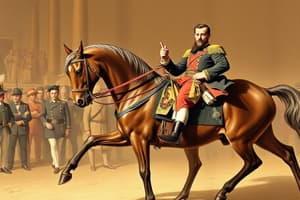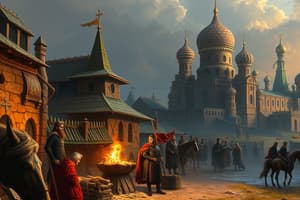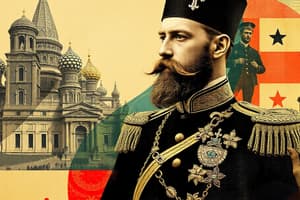Podcast
Questions and Answers
What was the primary aim of Alexander II's domestic reform in relation to the central government?
What was the primary aim of Alexander II's domestic reform in relation to the central government?
- To empower the ministers with full control over legislative processes
- To completely dismantle the existing autocratic system
- To grant significant power to local governments
- To enhance the efficiency of the central government apparatus (correct)
Which of the following statements best captures the impact of the reforms on the tsar's power?
Which of the following statements best captures the impact of the reforms on the tsar's power?
- The tsar's power was significantly reduced in favor of the ministers.
- The reforms initiated a transfer of power to local governments.
- The tsar maintained his power, with reforms occurring at his discretion. (correct)
- Reforms led to a democratic shift in the power structure of the government.
What was a notable characteristic of Alexander II's attitude towards reform?
What was a notable characteristic of Alexander II's attitude towards reform?
- His approach was indifferent and unresponsive to public demands.
- He sought reforms solely to increase his autocratic rule.
- He had an open attitude and was willing to initiate reforms. (correct)
- He was resistant to change and preferred traditional methods.
The reforms organized by Alexander II were primarily driven by which factor?
The reforms organized by Alexander II were primarily driven by which factor?
How did the impact of the central government reforms affect opposition in Russian society?
How did the impact of the central government reforms affect opposition in Russian society?
What can be inferred about the extent of central government reform under Alexander II?
What can be inferred about the extent of central government reform under Alexander II?
What does the term 'impact of reform' in the context of Alexander II's reforms refer to?
What does the term 'impact of reform' in the context of Alexander II's reforms refer to?
What can be concluded about the legislative process under Alexander II post-reform?
What can be concluded about the legislative process under Alexander II post-reform?
What was a key change in primary education during Alexander II's reign?
What was a key change in primary education during Alexander II's reign?
What two types of secondary education were established under Dmitri Tolstoy's reforms?
What two types of secondary education were established under Dmitri Tolstoy's reforms?
Which aspect of tertiary education reforms under Tolstoy primarily emphasized limitations?
Which aspect of tertiary education reforms under Tolstoy primarily emphasized limitations?
By 1881, how did the literacy rates of peasants compare to those of nobles?
By 1881, how did the literacy rates of peasants compare to those of nobles?
What was the approximate increase in middle-class literacy from 1857 to 1881?
What was the approximate increase in middle-class literacy from 1857 to 1881?
Which of the following best describes the overall impact of the education reforms initiated under Alexander II?
Which of the following best describes the overall impact of the education reforms initiated under Alexander II?
What was one of the main reasons for the creation of different types of secondary schools?
What was one of the main reasons for the creation of different types of secondary schools?
How did censorship change during Alexander II's reign?
How did censorship change during Alexander II's reign?
What factor did NOT contribute to the education reform's impact on society?
What factor did NOT contribute to the education reform's impact on society?
Which group primarily benefited from the educational reforms in secondary education?
Which group primarily benefited from the educational reforms in secondary education?
What did Golovin's reforms introduce to universities?
What did Golovin's reforms introduce to universities?
Which of the following statements regarding women's education during Alexander II's reign is true?
Which of the following statements regarding women's education during Alexander II's reign is true?
What was the overall literacy rate comparison between Russia and Western countries by 1881?
What was the overall literacy rate comparison between Russia and Western countries by 1881?
What was the main goal of Alexander II regarding the need for educated individuals?
What was the main goal of Alexander II regarding the need for educated individuals?
What was the main purpose of creating the zemstva in 1864?
What was the main purpose of creating the zemstva in 1864?
What was a key area that the zemstva were not given control over?
What was a key area that the zemstva were not given control over?
How did the legal reforms introduced by Alexander II intend to address bribery?
How did the legal reforms introduced by Alexander II intend to address bribery?
Which of the following was a result of the legal reform's unintended consequences?
Which of the following was a result of the legal reform's unintended consequences?
What significant change occurred in military service as a result of Miliutin's reforms in 1874?
What significant change occurred in military service as a result of Miliutin's reforms in 1874?
What was an argument made by critics regarding the zemstva's power?
What was an argument made by critics regarding the zemstva's power?
What reform did the legal changes established by Alexander II introduce related to trials?
What reform did the legal changes established by Alexander II introduce related to trials?
Which sector of local administration did the dumas have responsibility for in Russian towns?
Which sector of local administration did the dumas have responsibility for in Russian towns?
What was a requirement for issuing any new periodical publication in Russia during the reforms?
What was a requirement for issuing any new periodical publication in Russia during the reforms?
Which of the following was a feature of the military reform enacted in 1864?
Which of the following was a feature of the military reform enacted in 1864?
How did the reforms of Alexander II affect the relationship between publishers and censors?
How did the reforms of Alexander II affect the relationship between publishers and censors?
Which of the following best describes the intended outcome of the legal reforms under Alexander II?
Which of the following best describes the intended outcome of the legal reforms under Alexander II?
Which social class benefitted the most from the reduction of censorship?
Which social class benefitted the most from the reduction of censorship?
What was one reason for the growing opposition in Russia during Alexander II's reign?
What was one reason for the growing opposition in Russia during Alexander II's reign?
What was one of the unintended consequences of the reforms related to censorship?
What was one of the unintended consequences of the reforms related to censorship?
What was a significant feature of the zemstva's functioning in local areas?
What was a significant feature of the zemstva's functioning in local areas?
What was the main goal of Alexander II’s economic reforms?
What was the main goal of Alexander II’s economic reforms?
How did the introduction of oral evidence and cross-examination in trials impact public perception?
How did the introduction of oral evidence and cross-examination in trials impact public perception?
What change occurred in military service for university graduates under the 1874 reforms?
What change occurred in military service for university graduates under the 1874 reforms?
What was the outcome of railway expansion during Alexander II's reign?
What was the outcome of railway expansion during Alexander II's reign?
What key feature was introduced in the financial sector during the reforms?
What key feature was introduced in the financial sector during the reforms?
What kind of exports saw a significant increase from 1864 to 1880?
What kind of exports saw a significant increase from 1864 to 1880?
Which government figure was responsible for publishing budgets during 1862-1878?
Which government figure was responsible for publishing budgets during 1862-1878?
What was one of the key sectors that Reutern focused on to enhance revenue?
What was one of the key sectors that Reutern focused on to enhance revenue?
What did the reforms aim to limit access to, affecting the availability of certain texts?
What did the reforms aim to limit access to, affecting the availability of certain texts?
During Alexander II's time, what was the primary source of investment for businesses?
During Alexander II's time, what was the primary source of investment for businesses?
What was the overall impact on book publishing in Russia between 1864 and 1881?
What was the overall impact on book publishing in Russia between 1864 and 1881?
Which of the following best describes the agricultural status of Russia before Alexander II’s reforms?
Which of the following best describes the agricultural status of Russia before Alexander II’s reforms?
What was a benefit of the economic reforms under Alexander II for the Russian economy?
What was a benefit of the economic reforms under Alexander II for the Russian economy?
Which group was most directly affected by the abolition of the 'Pale of Settlement' in 1865?
Which group was most directly affected by the abolition of the 'Pale of Settlement' in 1865?
How did the economic reforms of Alexander II impact Russia's performance in wars?
How did the economic reforms of Alexander II impact Russia's performance in wars?
What was a key limiting factor on the extent of Alexander II’s reforms?
What was a key limiting factor on the extent of Alexander II’s reforms?
Which foreign expert played a significant role in developing the Russian textile industry?
Which foreign expert played a significant role in developing the Russian textile industry?
What effect did the economic reforms have on the upper classes in Russia during Alexander II’s reign?
What effect did the economic reforms have on the upper classes in Russia during Alexander II’s reign?
What was one consequence of Alexander II's redemption payments on serfs?
What was one consequence of Alexander II's redemption payments on serfs?
In comparison to western powers, how did Russia's economic position stand after Alexander II's reforms?
In comparison to western powers, how did Russia's economic position stand after Alexander II's reforms?
What was one of Alexander II's aims during his reign?
What was one of Alexander II's aims during his reign?
How did the reforms affect the middle class in Russia?
How did the reforms affect the middle class in Russia?
What was the result of the Emancipation of the Serfs under Alexander II?
What was the result of the Emancipation of the Serfs under Alexander II?
What did Alexander II fail to achieve regarding the military during his reign?
What did Alexander II fail to achieve regarding the military during his reign?
Which of the following statements about Alexander II's domestic reforms is true?
Which of the following statements about Alexander II's domestic reforms is true?
Flashcards are hidden until you start studying
Study Notes
Central Government
- Limited reform efficiency with the tsar maintaining absolute power; reforms initiated to uphold autocracy.
- The lack of representative institutions contributed to rising opposition, leading historians to debate the potential effects of earlier institutional reforms.
Local Government
- Establishment of zemstva (1864) in rural areas and dumas (1870) in towns facilitated local control over education, health, and infrastructure.
- Local representation improved, although taxation still favored nobility and policing remained under central control.
- Zemstva involvement in reform discussions indicated growing local competence and desire for greater authority.
Legal Reform
- Significant reforms aimed at establishing a fair and independent judiciary, including public trials and jury systems.
- Intended outcomes achieved with reduced corruption and increased public trust; courts handled more cases than expected.
- Unintended consequences included a rise in trained legal professionals that later became involved in revolutionary movements.
Military Reform
- Major reforms introduced by Minister of War Miliutin aimed at modernizing the military structure and practices from 1859 to 1874.
- Conscription period reduced from 25 to 16 years; service obligations expanded to all classes in 1875.
- Despite structural improvements, issues like bribery and inadequate training persisted, limiting effectiveness until later reforms.
Education
- Education reform significantly increased enrollment, with primary school numbers quadrupling from 1861 to 1881.
- Secondary education focused on middle-class access; universities granted more autonomy but remained under strict police oversight.
- Rising literacy rates (from 12% to 20% among peasants and 37% to 46% among middle classes) reflected educational improvements, though still lagged behind Western nations.
Censorship
- Reforms reduced censorship somewhat, leading to a tripling of published books and fostering a cooperative relationship between publishers and censors.
- Increased literary output primarily benefitted the literate middle and upper classes, promoting discussion and political ideas.
- Unintended consequences included a burgeoning intelligentsia that became increasingly critical of the regime, linked to opposition and revolutionary sentiment.
Economic Reform
- Economic reforms were crucial for transitioning Russia from agriculture to industrialization; highlighted by the rise of railway construction.
- Railway mileage expanded dramatically from 700 miles in 1855 to 14,000 miles by 1881, crucial for economic development.
- Introduction of public budgets and excise duties under finance minister Reutern aimed to streamline revenue generation and modernization efforts.### Economic Reforms and Exports
- Grain exports increased from 26 million tons in 1864 to 86 million tons in 1880, marking significant growth in the agricultural sector.
Financial Institutions Development
- Prior to 1855, businesses primarily depended on moneylenders.
- By 1878, infrastructure consisted of 278 municipal banks, 727 loan and savings associations, 566 joint-stock companies, and 33 joint-stock commercial banks, facilitating capital access for businesses.
Jewish Economic Policies
- Up to 1855, Jews were restricted to the ‘Pale of Settlement.’
- In 1859, Jewish merchants of the First Guild and all foreign Jews gained the right to live and trade throughout the empire.
- 1860 reforms allowed Jews serving in certain regiments to live and trade beyond the Pale.
- The 1865 policy abolished the Pale for Jewish artisans, enabling broader participation in economic activities.
- By 1867, all Jewish soldiers were permitted the same liberties.
- Despite economic liberalization, antisemitic policies persisted, including school closures and limited representation.
Role of Foreign Experts and Investment
- Foreign investment was vital for Russia's industrial expansion during this time.
- Ludwig Loop from Manchester contributed to the development of the Russian textile industry.
- The Nobel Brothers from Sweden advanced the oil industry in Baku (modern Azerbaijan).
- J.J. Hughes from Wales transformed iron and steel production in Ekaterinoslav, ultimately founding Donetsk.
Impact of Economic Reforms Under Alexander II
- Economic reforms resulted in increased production, exports, and a faster industrialization rate compared to previous periods.
- The financial system improved significantly, enabling businesses to invest and grow.
- Foreign expertise introduced modern production methods, influencing military performance in conflicts like the Russo-Turkish War.
- Despite progress, Russia lagged behind other industrialized nations due to a low starting point and constraints from the Emancipation of the Serfs.
Aims and Limitations of Alexander II's Reforms
- Aims included modernizing the military, catching up economically with the West, ensuring stability post-serfdom, and maintaining autocracy.
- Domestic reforms were unprecedented under tsarism, significantly impacting various societal sectors.
- The reforms benefitted the middle class through improved education and local government representation.
- Peasants gained freedom but largely continued traditional lifestyles.
- Upper classes faced diminishing influence due to legal and governmental reforms.
- Alexander II’s focus on maintaining autocracy limited the extent of reforms, exemplified by restricted local governance and education controls.
Overall Assessment
- While Alexander II’s reforms fostered significant change, they ultimately fell short of fully achieving the desired aims, particularly in military modernization and economic competitiveness.
- Stability post-serfdom was only partially realized, leading to increased activism among the intelligentsia.
- The potential for a representative assembly could have bolstered efforts to stabilize society more effectively.
Studying That Suits You
Use AI to generate personalized quizzes and flashcards to suit your learning preferences.




